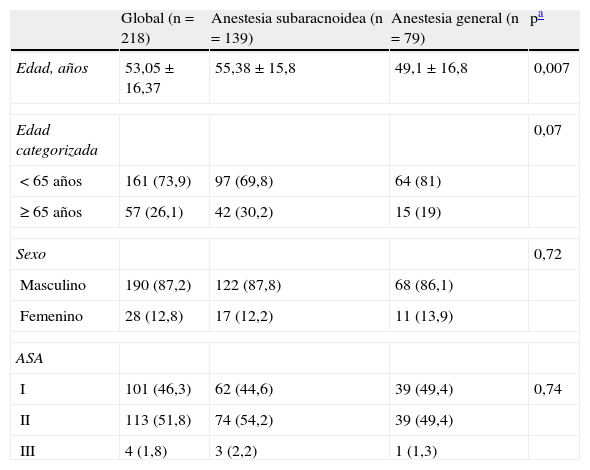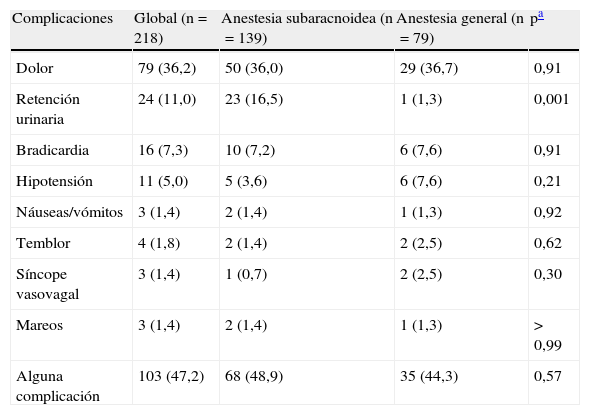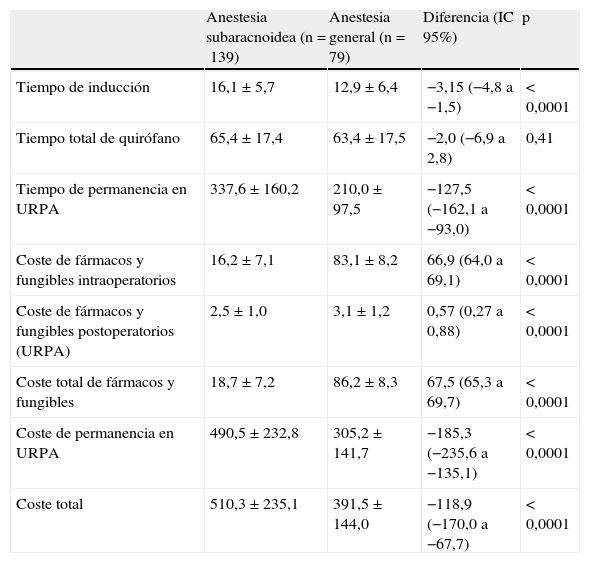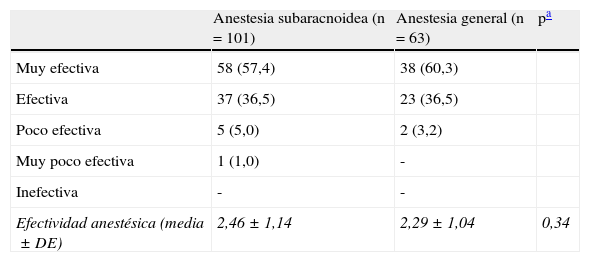Comparar los costes variables en relación con la efectividad clínica de la utilización de anestesia general frente a anestesia subaracnoidea en la cirugía ambulatoria de la hernia inguinal.
Material y métodosEstudio observacional, de cohortes, retrospectivo, con medición y análisis del coste-efectividad, realizado en una unidad de cirugía ambulatoria de un hospital general entre enero de 2010 y diciembre de 2011. Se incluyeron pacientes mayores de 18 años con tratamiento quirúrgico de la hernia inguinal primaria unilateral. Los tiempos de inducción anestésica y permanencia en quirófano y en unidad de recuperación postanestésica, la efectividad anestésica (incidencia de efectos adversos y el grado de bienestar del paciente) y los costes variables asociados al consumo de fármacos y utilización de recursos humanos fueron comparados.
ResultadosSe incluyeron 218 pacientes, el 87,2% hombres, con una edad media de 53 años (rango 18 a 85 años). Ciento treinta y nueve (63,76%) pacientes recibieron anestesia subaracnoidea, y 79 (36,2%), anestesia general. La permanencia en recuperación postanestésica fue de 337,6±160,2min en el grupo de anestesia subaracnoidea y de 210,0±97,5min para el grupo de anestesia general (p<0,001). Los costes de los fármacos para anestesia general fueron mayores que para subaracnoidea (86,2±8,3 frente a 18,7±7,2). La diferencia del coste total entre ambas técnicas fue de 115,8€, mayor para el grupo de anestesia subaracnoidea (p<0,001).
ConclusionesLa anestesia subaracnoidea y la general muestran una efectividad similar, pero los costes globales para la primera son mayores que para la segunda. La relación coste-efectividad es más favorable para la anestesia general que para la subaracnoidea en hernioplastia ambulatoria.
To compare the costs related to the clinical effectiveness of general anesthesia versus spinal anesthesia in inguinal hernioplasty ambulatory surgery.
Material and methodsAn observational, retrospective cohort study measurement and analysis of cost-effectiveness, in the ambulatory surgery unit of a general hospital. All patients over 18 years of age diagnosed with primary inguinal hernia and scheduled for unilateral hernioplasty between January 2010 and December 2011 were included. Duration of anesthetic induction, length of stay in both the operating room, and in the post-anesthesia care unit, the anesthetic effectiveness (the incidence of adverse effects and the patient's comfort level), and variable economic costs associated with the use of drugs, as well as the use of human resources, were compared.
ResultsThe final analysis included 218 patients, 87.2% male, with a mean age of 53 years (range: 18-85 years). Of these, 139 (63.76%) received subarachnoid anesthesia and 79,(36.2%) general anesthesia. The length of time a patient remained in the post-anesthesia care unit was 337.6±160.2min in the subarachnoid anesthesia group, and 210.0±97.5min for the general anesthesia group (P<.001). Costs of drugs for general anesthesia were higher than that for subarachnoid anesthesia (86.2±8.3 vs. 18.7±7.2). The total cost difference between the 2 techniques was €115.8 more for subarachnoid anesthesia (P<.001).
ConclusionsBoth techniques showed similar effectiveness. The overall costs for subarachnoid anesthesia were greater than for the general. The cost-effectiveness of general anesthesia is better for outpatient inguinal hernia repair surgery.
Artículo
Comprando el artículo el PDF del mismo podrá ser descargado
Precio 19,34 €
Comprar ahora












